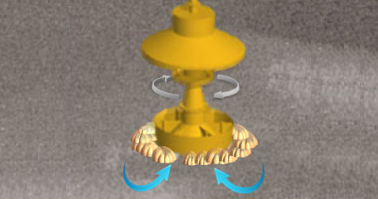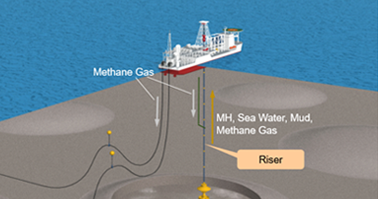Offshore Methane Hydrate
Effort toward commercialization of shallow methane hydrate development
The seabed of Japan's exclusive economic zone (EEZ) contains various resources including shallow methane hydrate, sandy layer type methane hydrate, sea-floor hydrothermal deposits, rare-earth elements mud and cobalt rich crust, and there are high expectations for future development with a view to harvesting these materials from the seabed as 100% domestically-produced resources.
In particular, shallow methane hydrate--an ice-like solid material composed of water and methane molecules--can only exist in stable form under the low-temperature, high-pressure conditions of the seabed. The survey of the resources has been conducted by Ministry of Economy, Trade and Industry (METI) and it was confirmed that 1742 gas chimney structures where shallow methane hydrate is believed to exist in the sea around Japan. It is estimated that there will be 600 million cubic meters of methane gas equivalent in the Umitaka mount structure off Joetsu area in FY2016.
Toward commercialization of shallow methane hydrate development, MODEC, as one of the leading companies in offshore oil and gas production platform field, is working on research and development to apply to shallow methane hydrate development by utilizing design technique and O&M experience of the offshore platform.
Overview of shallow methane hydrate recovery method

Wide-range vertical mining method using large-diameter drills
For more than 25 years, ore has been commercially mined and lifted from seabed diamond deposits at depths of up to 200 m off the coast of West Africa. Our company is seeking to employ this mining and lifting technology in developing shallow methane hydrate as a resource.
The wide-range vertical mining method is a method for drilling with large-diameter drills lowered from ships that offers the following benefits:
- It can be used with complex seabed terrain and fragile seabed ground.
- The drilled material is sucked up with the surrounding seawater, so no high turbidity water is produced.

On-board separation method
Seawater, methane hydrate, mud and methane gas are lifted aboard.
The lifted methane hydrate is broken down by heating it inside a sealed gasification tank, and then the methane gas alone is retrieved from the tank.
Returning the residual lifted material from the tank to the seabed in its original state without allowing the material to mix or come into contact with the air or surface seawater minimizes any environmental impacts from the process. Gas production via this method thus brings lifted material from the seabed to the surface and then returns it to the sea or the seabed in a completely closed circuit.

Gas lift method
The gas lift method used as lifting technology for shallow methane hydrate involves injecting compressed gas into risers to lift material from the seabed to the ship. In the course of lifting shallow methane hydrate, the methane hydrate within risers breaks down and gasifies, producing its own gas lift effect and making lifting more efficient. The lifting equipment is not submerged into the sea, making it easier to maintain the equipment and to handle any breakdowns that do occur.




